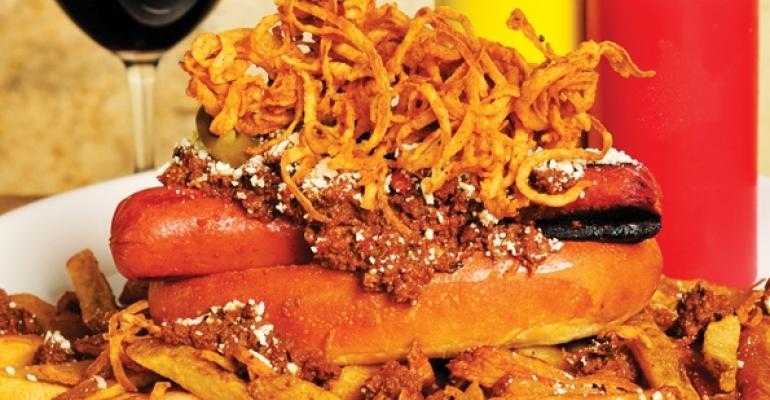![]() Max’s Wine Dive has found a niche by combining a menu of “gourmet comfort food” that’s localized for each market with retail wine sales that provide a stable revenue stream and allow customers to take home a piece of the experience.
Max’s Wine Dive has found a niche by combining a menu of “gourmet comfort food” that’s localized for each market with retail wine sales that provide a stable revenue stream and allow customers to take home a piece of the experience.
The four-unit Houston-based concept, an offshoot of owner Lasco Enterprises LLC’s Tasting Room Wine Cafes, opened in 2006 and features such combinations as fried chicken and champagne.
“We tapped into the emerging trend of comfort food,” said Jonathan Horowitz, partner in Lasco. “We [juxtapose] a very serious food and wine program with a bit of fun and little bit of irreverence.”
Half the menu is made up of more traditional comfort foods, while the other half varies from location to location.
“The chef in each city has the ability to shape 50 percent of the menu based on what they are good at, what they want to cook, what the demographics in that location call for,” Horowitz said.![]() He said the chef in Austin, Texas, offers farm-to-table selections, while the chef in Houston emphasizes Italian influences, and the one in Dallas puts an Asian spin on his food.
He said the chef in Austin, Texas, offers farm-to-table selections, while the chef in Houston emphasizes Italian influences, and the one in Dallas puts an Asian spin on his food.
Max’s Wine Dive also includes a Discoveries and Selections wine menu, which features labels created expressly for the chain.
Every wine on the menu is available for retail sale, and retail wine sales account for 15 percent to 20 percent of total sales.
“The retail pricing is a bit lower than the pricing on the menu for on-premise consumption,” Horowitz noted.
Selling wine retail “is a good point of distinction,” said Chris Tripoli, president of the A’La Carte Foodservice Consulting Group in Houston. “It’s unique compared to other casual dining, but not their main attraction.”![]() Tripoli also called the half-standard, half-localized menu a clever twist.
Tripoli also called the half-standard, half-localized menu a clever twist.
“The fact that they are able to present a consistent core product line while allowing each unit to customize some of the menu to its respective community is a very creative way to maintain trade dress and individuality,” Tripoli said. “Guests are more knowledgeable than ever and seem to appreciate both consistency and creativity. ... I like that in a day of increasing ‘sameness’ in casual dining.”
Currently, Lasco is looking for more locations in Texas, especially in Fort Worth and Houston. Horowitz said the concept would also work well in the high-traffic, bustling urban areas of Portland, Ore.; Seattle; Chicago; and Denver.
“The traffic has to be people with high discretionary income, who appreciate good food and wine experiences, travel, and those things,” he said.
Contact Ron Ruggless at [email protected].
Follow him on Twitter: @RonRuggless

